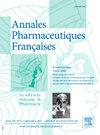通过非靶向代谢组学方法了解长期服用西洛多辛的副作用
IF 1.1
Q4 PHARMACOLOGY & PHARMACY
引用次数: 0
摘要
背景:精准医疗(precision medicine)是一种追求高效、低毒的治疗方法,随着omics技术的发展而越来越受欢迎。本研究旨在通过了解西洛多辛引起的副作用与用药相关代谢组学特征之间的复杂关系,发掘创新的低毒性疗法:采用 LC-Q-TOF/MS/MS 分析对照组和西洛多辛治疗组大鼠的血浆样本。采用 LC-Q-TOF-MS/MS 分析对照组和西洛多辛治疗组大鼠的血浆样本。利用 XCMS 和 MetaboAnalyst 软件处理 MS/MS 数据,以检测化合物并研究代谢途径。MATLAB 2019b 用于数据分类和多元分析。通过全面比较 METLIN 和 HMDB 数据库,发现药物治疗组和对照组之间有 41 个 m/z 值存在显著差异(pResults:根据多元数据分析,与对照组相比,17-β-雌二醇、牛胆酸、L-犬尿氨酸、N-甲酰犬尿氨酸、D-谷氨酰胺、L-精氨酸、前列腺素 H2、前列腺素 G2、15-酮前列腺素 E2、降钙素二醇、血栓素 A2、5'-甲硫基腺苷、L-蛋氨酸和 S-腺苷蛋氨酸的水平发生了显著变化。通过代谢途径分析,成功证实了甘油磷脂、酪氨酸、苯丙氨酸、花生四烯酸、半胱氨酸和蛋氨酸的代谢以及苯丙氨酸、酪氨酸、色氨酸和氨基酰-tRNA的生物合成存在差异。根据这项研究,建议补充维生素 D、L-谷氨酰胺和 L-精氨酸,以防止西洛多辛治疗过程中出现疲劳、术中虹膜松弛综合征 IFIS、视力模糊和头晕等副作用。西洛多辛治疗通过影响犬尿氨酸和色氨酸代谢途径对免疫系统产生负面影响:该研究为西洛多辛治疗提供了指导,在精准医疗的范围内,西洛多辛治疗可提供低副作用和高疗效。本文章由计算机程序翻译,如有差异,请以英文原文为准。
Understanding the side effects of chronic silodosin administration via untargeted metabolomics approach
Background
Precision medicine, which looks for high efficacy and low toxicity in therapies, has increased in popularity with omics technology. This work aims to discover novel and low-toxicity therapy options by examining the complex relationship between silodosin-induced side effects and the metabolomic profiles associated with its administration.
Materials and methods
The plasma samples of the control group and silodosin-treated rats were analyzed by LC-Q-TOF-MS/MS. Employing XCMS and MetaboAnalyst software, MS/MS data processed to detect compounds and investigate metabolic pathways. MATLAB 2019b was used for data categorization and multivariate analysis. A thorough comparison of METLIN and HMDB databases revealed 41 m/z values with significant differences between the drug-treated and control groups ( p < 0.01 and fold analysis ≥ 1.5).
Results
According to multivariate data analysis, 17-β-estradiol, taurocholic acid, L-kynurenine, N-formylkynurenine, D-glutamine, L-arginine, prostaglandin H2, prostaglandine G2, 15-keto-prostaglandin E2, calcidiol, thromboxane A2, 5′-methylthioadenosine, L-methionine and S-adenosylmethionine levels changed significantly compared to the control group. Differences in the metabolisms of glycerophospholipid, tyrosine, phenylalanine, arachidonic acid, cysteine and methionine, and biosynthesis of phenylalanine, tyrosine, and tryptophan, and aminoacyl-tRNA have been successfully demonstrated by metabolic pathway analysis. According to this study, vitamin D, D-glutamine, and L-arginine supplements can be recommended to prevent side effects such as fatigue, intraoperative floppy iris syndrome, blurred vision, and dizziness in the treatment of silodosin. Silodosin treatment negatively affected the immune system by affecting the kynurenine and tryptophan metabolism pathways.
Conclusions
The study is a guide for silodosin treatments that offer low side effects and high therapeutic effect within the scope of precision medicine.
Contexte
La médecine de précision, qui recherche une efficacité élevée et une faible toxicité dans les thérapies, a gagné en popularité grâce à la technologie omics. Ce travail vise à découvrir de nouvelles options thérapeutiques à faible toxicité en examinant la relation complexe entre les effets secondaires induits par la silodosine et les profils métabolomiques associés à son administration.
Matériaux et méthodes
Les échantillons de plasma du groupe témoin et des rats traités à la silodosine ont été analysés par LC-Q-TOF-MS/MS. Les logiciels XCMS et MetaboAnalyst ont été utilisés pour traiter les données MS/MS afin d’identifier les métabolites et d’analyser les voies métaboliques. MATLAB 2019b a été utilisé pour catégoriser les données afin d’effectuer une analyse de données multivariée. Une comparaison des bases de données METLIN et HMDB a révélé que les valeurs de 41 m/z entre les groupes médicamenteux et témoins différaient de manière significative (p < 0,01 et analyse de pli ≥ 1,5).
Résultat
Selon l’analyse de données multivariées, 17-β-Estradiol, acide taurocholique, L-kynurénine, N-formylkynurénine, D-glutamine, L-arginine, prostaglandine H2, prostaglandine G2, 15-keto-prostaglandine E2, calcidiol, thromboxane A2, les niveaux de 5′-méthylthioadénosine, de L-méthionine et de S-adénosylméthionine ont changé de manière significative par rapport au groupe témoin. Les différences dans les métabolismes du glycérophospholipide, de la tyrosine, de la phénylalanine, de l’acide arachidonique, de la cystéine et de la méthionine, ainsi que dans la biosynthèse de la phénylalanine, de la tyrosine et du tryptophane, ainsi que de l’aminoacyl-ARNt, ont été démontrées avec succès par l’analyse des voies métaboliques. Selon cette étude, des suppléments de vitamine D, de D-glutamine et de L-arginine peuvent être recommandés pour prévenir les effets secondaires tels que la fatigue, syndrome de l’iris souple peropératoire, la vision floue et les étourdissements lors du traitement à la silodosine. Le traitement à la silodosine a affecté négativement le système immunitaire en affectant les voies métaboliques de la kynurénine et du tryptophane.
Conclusions
L’étude est un guide pour les traitements à la silodosine qui offrent de faibles effets secondaires et un effet thérapeutique élevé.
求助全文
通过发布文献求助,成功后即可免费获取论文全文。
去求助
来源期刊

Annales pharmaceutiques francaises
PHARMACOLOGY & PHARMACY-
CiteScore
1.70
自引率
7.70%
发文量
98
期刊介绍:
This journal proposes a scientific information validated and indexed to be informed about the last research works in all the domains interesting the pharmacy. The original works, general reviews, the focusing, the brief notes, subjected by the best academics and the professionals, propose a synthetic approach of the last progress accomplished in the concerned sectors. The thematic Sessions and the – life of the Academy – resume the communications which, presented in front of the national Academy of pharmacy, are in the heart of the current events.
 求助内容:
求助内容: 应助结果提醒方式:
应助结果提醒方式:


